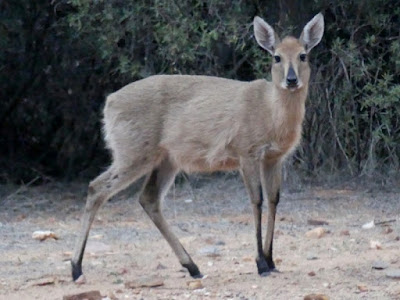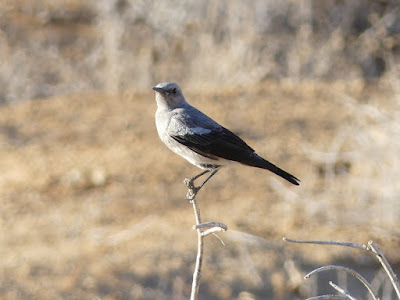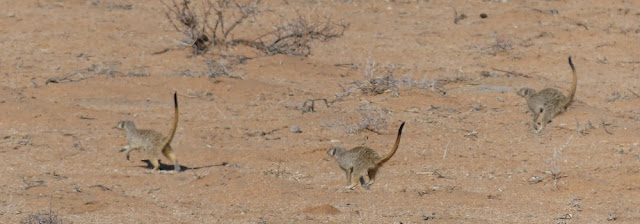As my more assiduous readers may recall - and I understand that there are a few of those! - in 2019, not long before COVID profoundly altered travel, we made a very special trip to East and South Africa to celebrate a new stage in our life. We were guided (excellently) in Kenya and Tanzania but hired a car and did our own thing in western South Africa. I've reported on aspects of the odyssey here of course, but today I want to share with you three much more modest little reserves in the arid north-west of South Africa. As suggested in the title, we had very little time in each of them and they all deserved more, but even those brief visits were memorable. Maybe more time, another time?
This country is arid, with dunes to the east and vast piles of tumbled granites to the west. Some of it reminds me strongly of parts of inland Australia. We loved it, but were restricted by time and by our little 2WD hire car. Here are three little reserves, two of which were quite unexpected, in which we spent a total of just two nights and all of which we'd happily return to for longer.
 |
From east to west (the order in which we visited them) W = Witsand Nature Reserve,
G = Geogap Nature Reserve, B = Brandrivier private reserve and farm.
|
Witsand was completely spur of the moment. We were in Upington for a couple of nights and not especially enjoying it. It is a busy industrial frontier town and at the time cold and rainy. Our search for the 'River Park' ended in a housing estate, and we then and there decided to forfeit the second night of our rather strange accommodation and book a cabin at Witsand Nature Reserve, supposedly only 100k away. Well, that turned out to be only to the little town of Grooblershoop, with another hundred after that. Our GPS - for which we paid almost as much per day as for the car - was incompetent and unreliable throughout the trip, and our excellent Essential Birding Guide to Western South Africa was well out of date for this one (not its fault as I'd bought it 14 years previously). It was a frustrating and stressful trip and we'd pretty much given up on finding the reserve when we stumbled across a sign for the first time after some 70k of signless dirt (encouraged only by a friendly farmer), and arrived late in the afternoon, hours after we'd hoped. As we drove along the park boundary a pair of magnificent Kudu effortlessly hurdled the high fence, followed by a very athletic female who performed a side-twisting leap between the top two wires.and from then on it was all very good.
 |
As the name suggests, this is a sandy landcape, dominated by hardy arid-adapted
plants, and especially by Camelthorn Vachellia (fomerly Acacia) erioloba.
|
 |
Sunset, above and below; in my opinion nowhere does sunsets quite like the deserts.
|
 |
Early morning view from the dunes, across the white sands which give the reserve its name
to the distant red sands of the Kalahari Desert.
|
Rocky hills supported tough succulents.
 |
Euphorbia dregeana, a common and distinctive smooth succulent, found only
in this part of the world.
|
Perhaps this country is not to everyone's taste, but it definitely was to ours. The accommodation comprised a big living room and kitchen, and bedrooms and bathroom off an open verandah, with braai (barbeque to us) and busy bird bath outside. It was much bigger than we needed, but nothing smaller was available and we enjoyed it. Unfortunately, though unavoidably, we'd already booked our next accommodation (at the superb
Augrabies Falls NP) so could only stay a night at Witsand. From the verandah and lounge room windows we watched a family of Yellow Mongooses (including a confusing grey one) and a parade of birds.
 |
Acacia Pied Barbet Tricholaema leucomelas above
and Fiscal Flycatcher Melaenornis silens below at the water bath.
Both common species in this part of the world, and not considerate
of the photographer's needs re the sun, but a pleasure nonetheless.
|
 |
Familiar Chats Oenanthe familiaris are indeed familiar around dwellings,
chasing insects and generally ignoring us. This one was no exception.
|
At the foot of the dune, where the photo above of the distant Kalahari was taken, was a hide with another watering point but we failed to see anything there, which was surprising given the general dryness (drought as well as the usual nature of the area) but perhaps recent showers were responsible. However there was plenty of activity around the carpark and on the dunes, including a magnificent Gemsbok which climbed the dune from the other side while we were there.
 |
Gemsbok Oryx gazella, a very large and generally superb arid land
antelope from dry South Africa and Namibia. It is the largest of six
closely related species, weighing up to 250kg. This one showed a mild
interest in us, but not nearly as much as we showed it!
|
Other less dramatic animals also shared our early morning dune walk.
 |
Kalahari Scrub Robin Cercotricha paena, a flycatcher unrelated to either
Old World or Australian robins.
|
 |
Cape Glossy Starlings Lamprotornis nitens are widespread and common but nonetheless
stunners, and we never tired of them. This one caught the morning sun beautifully.
|
 |
Unfortunately I was unable to lay lens on the ever-busy Dusky Sunbird Cinnyris fuscus
which was feeding on the mistletoe, but the flowering plant is worth admiring in its own right.
|
And in the carpark was an excellent example of one of the most amazing bird nests in the world, the huge colonial structures of the whizzing little Sociable Weavers Philetairus socius, which I also find hard to get an acceptable photo of.
 |
These little weavers build the largest nest of any bird, containing up to a hundred families.
|
Other animals were easy to see along the reserve tracks...
 |
Springboks Antidorcas marsupialis of course are the animal emblem of South Africa, but
are only found in the arid west of the country and north into the Kalahari. This one looks
quite sleek on very little forage.
|
 |
Scrub Hares Lepus saxatilis are restricted to southern Africa
|
 |
Steenboks Raphicerus campestris are more widespread, extending to East Africa. They are
a small antelope, standing no more than 60cm high. By now the light had almost gone!
|
... and around the Visitors' Centre.
 |
The White-browed Sparrow Weaver Plocepasser mahali is a handsome weaver
which, like other weavers, nests colonially (but, unlike the Sociable Weaver, in separate nests).
|
 |
The Crimson-breasted Shrike (or Boubou) Laniarius atrococcineus is a truly spectacular
bird and the national bird of Namibia. Indeed we were so excited to see it as
we were leaving the park that I managed to leave my faithful field guide on
the roof of the car, and didn't notice its absence until I needed it later that day at Augrabies Falls!
Luckily I was able to replace it with a newer edition later at Springbok.
|
Even the drive out provided a couple of worthwhile stops on nearby roads.
 |
Namaqua Sandgrouse Pterocles namaqua. I'm a big fan of the desert-loving sandgrouse,
and these gorgeously patterned birds were a delight.
|
 |
Striped Ground Squirrel Euxerus erythropus, which was sun-basking by its burrow
and popped back after we pulled up to admire it. This one is found over virtually
the entire continent, and was our last animal sighting for Witsand.
|
Had we known about Witsand earlier we'd have booked a couple of nights there in our original planning, but such discoveries are what travel is about and our evening and morning there were well worth the angst of getting there!
From Witsand we drove to Augrabies Falls and after an excellent stay there drove another 300k further west to the delightfully named and busy town of Springbok in Namaqualand. I'd visited the nearby Goegap Nature Reserve on my previous visit in 2005, and wanted to show Lou this wonderful semi-desert rocky landscape. We had only a couple of hours before it closed but time enough to do the 13k all-vehicle loop (and how I'd love to do the longer 4WD circuit one day). The 15,000 hectare reserve was proclaimed and fenced in the 1960s, and some of the original wildlife was reintroduced.
Spring in Namaqualand is famous for its flowers, but we were there in June - and in drought. Some aloes provided colour though.
 |
Typical Goegap landscape - it's always dry of course, but not this dry.
|
 |
I'm not sure of the identity of this aloe, but it looked magnficent among the Goegap rocks.
|
The real highlights however were both mammals. Just after we entered the reserve a couple of little heads appeared above a bush in an especially open sandy area; I assumed they were spurfowl but then, to our delight, three Meerkats Suricata suricatta burst into a gallop across the sand with tails in the air and vanished into a culvert under the road. They were the only ones we saw for the trip and we were thrilled.
The other mammal highlight was much bigger and more relaxed about us, and equally exciting.
 |
Mountain Zebras Equus zebra are zebras of the hot dry rocky mountains, surviving in isolated
scattered populations mostly in Namibia. There are less than 3000 left in the wild. This was
the third zebra species (of three altogether) that we saw for our trip, which pleased us greatly.
These differ from the far more common Plains Zebra most obviously in the unstriped belly.
|
From here it was a short drive south along the highway to our Air BnB at Brandrivier. We were originally going to just stay in Springbok, but this promising-looking accommodation on private property popped up during our search and we crossed our fingers and booked it - good choice!
The walls are canvas, but you wouldn't call it a tent! It is set high above the highway which goes through the pass below. You can hear trucks sometimes, but they feel pretty remote. The magnificent verandah looks out over the valley one way, and up into the rocky hill behind. There's an excellent gas barbeque on the verandah and an outside shower among the rocks (plus a good indoor bathroom). Solar panels provide lights and there's a fridge. It certainly warranted more than a one-night stay!
 |
Looking over the valley - the highway runs in front of the hills - above and below.
|

 |
View of the rocks behind (and the barbeque).
|
From the balcony we watched the local wildlife.
 |
The engaging furry-tailed Dassie Rats Petromus typicus loafed on the ledges and hid in the
rock crevices just behind the cabin. They are ancient Africans, the only member of their entire
family, found in arid rocky sites from here north through western Namibia to Angola.
|
 |
This one fooled me for a while, until I discovered that the Mountain Wheatear
Myrmecocichla monticola, which I know as a black and white bird, also
comes in grey!
|
 |
Layard's Warbler Curruca layardi, an Old World warbler which is relatively uncommon,
though quite widespread. I'm not sure if it was searching the flowering shrub
for insects or fruits - either is possible.
|
 |
This is the lovely flower of the shrub above. I assume that it's in the Mytaceae family,
but beyond that I have idea - any assistance welcomed!
|
And the activity didn't end with nightfall, even in the cabin. Unfortunately I have no way of identifying either of these little residents, so if you can do so I'd be glad to hear from you.
 |
This little chap came out to clean up the barbeque even before it cooled,
and before I had a chance to do so. I'm pretty sure it's not a House Mouse,
but I don't what the options are there.
|
 |
Meet Bibron's Thick-toed Gecko Chondrodactylus bibronii (thanks to Roman below for pointing me
in the right direction). This beauty appeared after dark on the window frame,
though we don't know where it was lurking prior to that. It's a big gecko and apparently
relatively common across southern Africa.
|
So, three very different little reserves, each a treasure. This is one occasion when I'd be a bit surprised (pleasantly of course!) if anyone reading this has visited any of these reserves. If I'm wrong please let me know of your experience there. Otherwise, if you get the chance to visit any or all of them, try and give yourself more time in each of them than we did on this occasion - they, and you, richly deserve it.
NEXT POSTING THURSDAY 26 MAY
I
love to receive your comments and in future will be notifying you
personally by email when a new posting appears, if you'd like me to. All
current subscribers have been added to this mailing list and have
already been contacted. This will mean one email every three weeks at the current rate of posting. I promise never to use the list for any other purpose and will never share it.
Should you wish to be added to it, just send me an email at calochilus51@internode.on.net. You can ask to be removed from the list at any time,or could simply mark an email as Spam, so you won't see future ones.







































5 comments:
Thanks Ian. I enjoy your write ups. I learn and hope to read more from you. Tom Rogers Muyunga-Mukasa.
Thank you for another very enjoyable read Ian. After a bit of internet searching I think the gecko might be a Bibron's Thick-toed Gecko. Can't help you with the mouse though :-)
Best regards, Roman
Thanks for your encouragement Tom, and all the best with your work.
Thanks Roman, haven't heard from you for a while. Well done on the gecko, I'm afraid I didn't try hard enough. I'm convinced by your id, and have amended above. I'd have been even more impressed if you'd given me a name for the mouse! Cheers, Ian
Thank Ian
Post a Comment